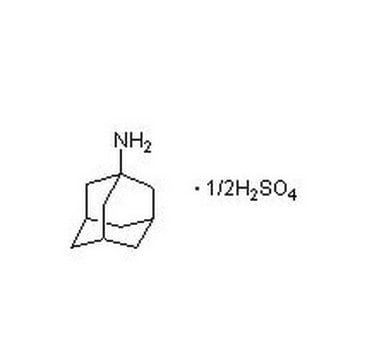A1260
Amantadine hydrochloride
≥98% (TLC), powder, NMDA receptor antagonist
Synonym(s):
1-Adamantanamine hydrochloride, 1-Adamantylamine hydrochloride, 1-Aminoadamantane hydrochloride, NSC 83653, Tricyclo[3.3.1.13,7]decan-1-amine hydrochloride
About This Item
Recommended Products
product name
Amantadine hydrochloride,
form
powder
solubility
H2O: 50 mg/mL
ethanol: soluble
originator
Endo
SMILES string
Cl[H].[H][C@@]12C[C@@]3([H])C[C@@]([H])(C1)CC(N)(C2)C3
InChI
1S/C10H17N.ClH/c11-10-4-7-1-8(5-10)3-9(2-7)6-10;/h7-9H,1-6,11H2;1H/t7-,8+,9-,10-;
InChI key
WOLHOYHSEKDWQH-SOVZANNPSA-N
Looking for similar products? Visit Product Comparison Guide
General description
Application
- to determine its effectiveness in reducing surgery-induced cognitive impairment
- to preincubate multipotent stem cells (MSCs), to investigate the cellular internalization pathway
- to determine whether amantadine-attenuated sepsis-induces neuroinflammation and dysfunction of learning and memory
- to preincubate primary cultured rat dental pulp stem cells (rDPSCs)
- to determine the pathway of internalization
Biochem/physiol Actions
Features and Benefits
Signal Word
Warning
Hazard Statements
Precautionary Statements
Hazard Classifications
Acute Tox. 4 Oral
Storage Class Code
11 - Combustible Solids
WGK
WGK 3
Flash Point(F)
Not applicable
Flash Point(C)
Not applicable
Personal Protective Equipment
Certificates of Analysis (COA)
Search for Certificates of Analysis (COA) by entering the products Lot/Batch Number. Lot and Batch Numbers can be found on a product’s label following the words ‘Lot’ or ‘Batch’.
Already Own This Product?
Find documentation for the products that you have recently purchased in the Document Library.
Customers Also Viewed
Articles
Discover Bioactive Small Molecules for ADME/Tox
Discover Bioactive Small Molecules for ADME/Tox
Discover Bioactive Small Molecules for ADME/Tox
Discover Bioactive Small Molecules for ADME/Tox
Our team of scientists has experience in all areas of research including Life Science, Material Science, Chemical Synthesis, Chromatography, Analytical and many others.
Contact Technical Service













